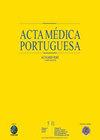Neurological Involvement in a Portuguese Cohort of IgG4-Related Disease.
IF 0.8
4区 医学
Q3 MEDICINE, GENERAL & INTERNAL
引用次数: 0
Abstract
INTRODUCTION Neurological involvement in immunoglobulin G4-related disease (IgG4-RD) is increasingly recognized. Its diagnosis can be challenging due to clinical mimics and difficulty in obtaining nervous system biopsies. The aim of this study was to describe a cohort of neurological IgG4-RD patients. METHODS Patients were recruited from a neuroimmunology tertiary center. Clinical, laboratory, neuroimaging and histological data were reviewed. RESULTS Fifteen patients (60% women), with a median age of 53 years (48.5 - 65.0) were included: 13 (86.7%) classified as possible IgG4-RD, one (6.7%) as probable and one (6.7%) as definitive. The most common neurological phenotypes were meningoencephalitis (26.7%), orbital pseudotumor (13.3%), cranial neuropathies (13.3%), peripheral neuropathy (13.3%), and longitudinally extensive transverse myelitis (LTEM) (13.3%). Median serum IgG4 concentration was 191.5 (145.0 - 212.0) mg/dL. Seven in 14 patients had CSF pleocytosis (50.0%) and oligoclonal bands restricted to the intrathecal compartment, while most cases presented elevated CSF proteins (64.3%). Magnetic resonance imaging abnormalities included white matter lesions in four (26.7%), hypertrophic pachymeningitis in two (13.3%), and LETM in two (13.3%). Two patients had biopsy-proven IgG4-RD in extra-neurological sites. CONCLUSION This study highlights the phenotypical variability of the neurological IgG4-RD. Biopsy inaccessibility reinforces the importance of new criteria for the diagnosis of this subset of patients.葡萄牙 IgG4 相关疾病队列中的神经系统受累。
简介:越来越多的人认识到免疫球蛋白 G4 相关疾病(IgG4-RD)会累及神经系统。由于临床表现相似且难以获得神经系统活检组织,其诊断具有挑战性。本研究旨在描述一组神经系统 IgG4-RD 患者。结果共纳入 15 名患者(60% 为女性),中位年龄为 53 岁(48.5 - 65.0):13例(86.7%)被归类为可能的IgG4-RD,1例(6.7%)被归类为可能的IgG4-RD,1例(6.7%)被归类为确定的IgG4-RD。最常见的神经系统表型为脑膜脑炎(26.7%)、眼眶假瘤(13.3%)、颅神经病(13.3%)、周围神经病(13.3%)和纵向广泛横贯性脊髓炎(LTEM)(13.3%)。血清 IgG4 浓度中位数为 191.5 (145.0 - 212.0) mg/dL。14例患者中有7例出现脑脊液多细胞(50.0%)和局限于脑室内的寡克隆带,而大多数病例出现脑脊液蛋白升高(64.3%)。磁共振成像异常包括四例患者(26.7%)出现白质病变,两例患者(13.3%)出现肥厚性脑桥炎,两例患者(13.3%)出现LETM。结论:本研究强调了神经系统 IgG4-RD 的表型变异性。活检的不可接近性加强了新标准对这部分患者诊断的重要性。
本文章由计算机程序翻译,如有差异,请以英文原文为准。
求助全文
约1分钟内获得全文
求助全文
来源期刊

Acta medica portuguesa
MEDICINE, GENERAL & INTERNAL-
CiteScore
1.90
自引率
16.70%
发文量
256
审稿时长
6-12 weeks
期刊介绍:
The aim of Acta Médica Portuguesa is to publish original research and review articles in biomedical areas of the
highest standard, covering several domains of medical
knowledge, with the purpose to help doctors improve medical care.
In order to accomplish these aims, Acta Médica Portuguesa publishes original articles, review articles, case reports and editorials, among others, with a focus on clinical,
scientific, social, political and economic factors affecting
health. Acta Médica Portuguesa will be happy to consider
manuscripts for publication from authors anywhere in the
world.
 求助内容:
求助内容: 应助结果提醒方式:
应助结果提醒方式:


